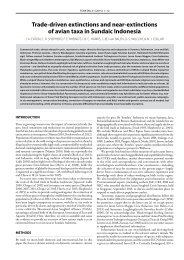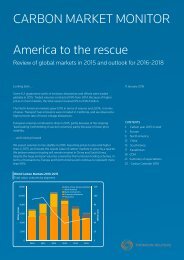Emissions Trading Worldwide
1TbjEHd
1TbjEHd
You also want an ePaper? Increase the reach of your titles
YUMPU automatically turns print PDFs into web optimized ePapers that Google loves.
the european union emissionS trading system<br />
(2008–2012), Phase three: Eight years (2013–2020), Phase four: Ten years<br />
(2021–2030)<br />
Allocation Phase one (2005–2007): Nearly 100% free allocation through<br />
grandfathering. Some Member States used auctioning and some used benchmarking.<br />
Phase two (2008–2012): Similar to Phase one with some benchmarking<br />
for free allocation and some a-uctioning in eight EU Member States (about<br />
3% of total allowances). Phase three (2013–2020): In 2013, about 40% of total<br />
allowances were auctioned, with different allocation rules for the electricity,<br />
manufacturing and aviation sectors. Electricity sector: 100% auctioning<br />
with optional derogation for the electricity sector in certain Member States. In<br />
line with the 2030 framework for climate and energy, Member States with a<br />
GDP per capita in 2013 below 60% of the EU average may continue to make<br />
use of this optional free allocation in Phase four. Manufacturing sector:<br />
Free allocation is based on benchmarks. Sub-sectors deemed at risk of carbon<br />
leakage will receive free allocations at 100% of the pre-determined benchmarks.<br />
Sub-sectors deemed not at risk of carbon leakage will have free allocation<br />
phased out gradually from 80% of the benchmarks in 2013 to 30% by 2020.<br />
Aviation sector: In 2012, 85% of allowances were allocated for free based<br />
on benchmarks. For Phase three (2012–2020): 15% of allowances are auctioned<br />
and 82% allocated for free based on benchmarks. The remaining 3%<br />
constitutes a special reserve for new entrants and fast growing airlines. Backloading:<br />
Taken as a short term measure to address a growing surplus in the<br />
EU ETS, it was agreed to postpone the auctioning of 900 million allowances<br />
until 2019–2020. Auction volumes were reduced by 400 million allowances in<br />
2014, 300 million in 2015, and by 200 million in 2016. In line with the decision<br />
to create an MSR, the back-loaded allowances will not be auctioned but be<br />
placed directly in the MSR. New Entrants Reserve: 5% of the total allowances<br />
are set aside to assist new installations coming into the EU ETS or covered<br />
installations whose capacity has significantly increased since their free allocation<br />
was determined. Phase four (2021–2030): On 15 July 2015, the European<br />
Commission proposed amendments to the EU ETS directive to enhance costeffective<br />
emission reductions and low-carbon investments. A central component<br />
of the proposed amendments refers to the continuation of transitory<br />
measures to address the risk of carbon leakage and a revision of the free<br />
allocation of allowances. According to the European Commission, the limited<br />
and declining number of allowances requires that the current system of free<br />
allocation be revised in order to distribute allowances in the most effective<br />
and efficient way.<br />
To this end, changes are proposed to: 1. Benchmark values, which will be<br />
updated to reflect technological progress in the different sectors. 2. Production<br />
data to better take into account production increases or decreases and to<br />
adjust the amount of free allocation accordingly. This should also make the<br />
EU ETS more flexible. 3. Carbon leakage, so the number of sectors receiving<br />
100% of the benchmark-based free allocation will be reduced. In addition, the<br />
European Commission proposed to transfer 250 million unused allowances<br />
from 2013–2020 to establish a reserve for new and growing installations.<br />
Compliance period From 1 January until 30 April the following year (16 months)<br />
Flexibility<br />
of CDM/JI credits are allowed (restrictions vary across different EU Member<br />
States), no credits from the land use, land-use change and forestry (LULUCF)<br />
and nuclear power sectors. Strict requirements apply for large hydro projects<br />
exceeding 20 MW. Since the start of Phase three (1 January 2013), additional<br />
restrictions apply for CDM: Newly generated (post-2012) international credits<br />
may only come from projects in Least Developed Countries (LDCs). Projects<br />
from industrial gas credits (projects involving the destruction of HFC-23 and<br />
N 2 O) are excluded regardless of the host country. Credits issued for emission<br />
reductions that occurred in the first commitment period of the Kyoto Protocol<br />
are no longer accepted as of 31 March 2015. Quantitative limit: In Phase two<br />
(2008–2012), operators were allowed to use JI and CDM credits up to a certain<br />
percentage limit determined in the respective country’s National Allocation<br />
Plans. Unused entitlements were transferred to Phase three (2013–2020). The<br />
total use of credits for Phase two and three may amount up to 50% of the<br />
overall reduction under the EU ETS in that period (approximately 1.6 billion<br />
tons CO 2e). Phase four (2021–2030): Currently no international offsets are<br />
envisaged.<br />
price management Provisions The EU ETS Directive provides for measures<br />
in the event of excessive price fluctuations. In July 2015, the European Council<br />
and the European Parliament agreed to adopt an instrument to stabi lize the<br />
market in line with the Commission’s proposal for a Market Stability Reserve at<br />
the beginning of 2019. This would address imbalances in supply and demand<br />
on the European carbon market by adjusting volumes for auctions, rather than<br />
directly managing prices. The MSR would operate on pre-defined rules with no<br />
discretion for Member State or European Commission intervention.<br />
compliance<br />
MRV Reporting frequency: Annual self-reporting based on harmonized<br />
electronic templates prepared by the European Commission. Verification:<br />
Verification by independent accredited verifiers is required before 31 March<br />
each year. Framework: For Phase three onwards, European Commission<br />
Regulations have been published for monitoring and reporting, and for verification<br />
and accreditation of verifiers. A monitoring plan is required for every<br />
installation and aircraft operator (approved by competent authority).<br />
Enforcement ‘Excess emissions penalty’ of EUR 100/tCO 2 emitted for which<br />
no allowance has been surrendered in due time. The name of the non-compliant<br />
operator is to be published. Different penalties exist at the national level<br />
for other non-compliances.<br />
other information<br />
Institutions involved The European Commission and the relevant authorities<br />
of the 28 Member States, Iceland, Liechtenstein and Norway.<br />
Linkage with other systems The European Commission has concluded<br />
negotiations with Switzerland on linking the EU ETS with the Swiss ETS.<br />
However, the link will only become operational once the agreement will have<br />
been signed and enters into force.<br />
Banking and borrowing Unlimited banking is allowed since 2008. Borrowing<br />
is not allowed.<br />
Offsets and Credits Phase one (2005–2007): Unlimited use of Clean<br />
Development Mechanism (CDM) and Joint Implementation (JI) credits. Phases<br />
two (2008–2012) and three (2013–2020): Qualitative limit: Most categories<br />
32




